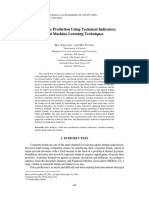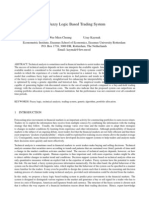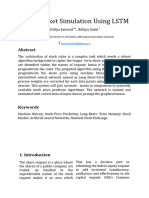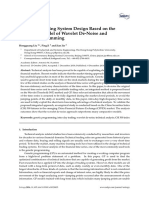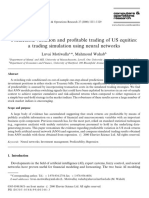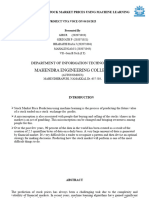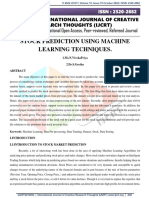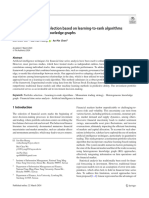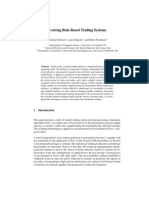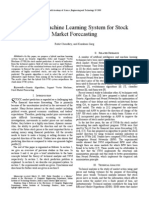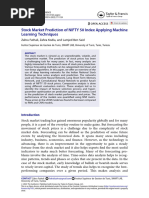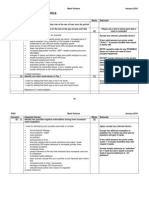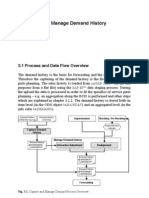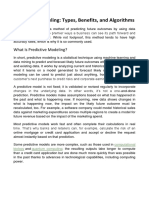$+/Eulg6/Vwhpe/,Qwhjudwlqj&Dvh%Dvhg5Hdvrqlqjdqg) X) ) / 'Hflvlrq7Uhhiru) Lqdqfldo7Lph6Hulhv'Dwd
$+/Eulg6/Vwhpe/,Qwhjudwlqj&Dvh%Dvhg5Hdvrqlqjdqg) X) ) / 'Hflvlrq7Uhhiru) Lqdqfldo7Lph6Hulhv'Dwd
Uploaded by
Yaşanur KayikciCopyright:
Available Formats
$+/Eulg6/Vwhpe/,Qwhjudwlqj&Dvh%Dvhg5Hdvrqlqjdqg) X) ) / 'Hflvlrq7Uhhiru) Lqdqfldo7Lph6Hulhv'Dwd
$+/Eulg6/Vwhpe/,Qwhjudwlqj&Dvh%Dvhg5Hdvrqlqjdqg) X) ) / 'Hflvlrq7Uhhiru) Lqdqfldo7Lph6Hulhv'Dwd
Uploaded by
Yaşanur KayikciOriginal Title
Copyright
Available Formats
Share this document
Did you find this document useful?
Is this content inappropriate?
Copyright:
Available Formats
$+/Eulg6/Vwhpe/,Qwhjudwlqj&Dvh%Dvhg5Hdvrqlqjdqg) X) ) / 'Hflvlrq7Uhhiru) Lqdqfldo7Lph6Hulhv'Dwd
$+/Eulg6/Vwhpe/,Qwhjudwlqj&Dvh%Dvhg5Hdvrqlqjdqg) X) ) / 'Hflvlrq7Uhhiru) Lqdqfldo7Lph6Hulhv'Dwd
Uploaded by
Yaşanur KayikciCopyright:
Available Formats
A Hybrid System by Integrating Case Based Reasoning and Fuzzy
Decision Tree for Financial Time Series Data
Pei-Chann Chang , Chin-Yuan Fan , Chia-Hsuan Yeh, Wan-Ling Pan
Abstract-Stock price predictions suffer from two well
known difficulties, i.e., complicated and non-stationary
variations within the large historic data. This paper establishes
a novel financial time series-forecasting model by a case based
fuzzy decision tree induction for stock price movement
predictions in Taiwan Stock Exchange Corporation (TSEC).
This forecasting model integrates a case based reasoning
technique, a Fuzzy Decision Tree (FDT), and Genetic
Algorithms (GA) to construct a decision-making system based
on historical data and technical indexes. The model is major
based on the idea that the historic price data base can be
transformed into a smaller case-base together with a group of
fuzzy decision rules. As a result, the model can be more
accurately react to the current tendency of the stock price
movement from these smaller case based fuzzy decision tree
inductions. Hit rate is applied as a performance measure and
the effectiveness of our proposed CBFDT model is
demonstrated by experimentally compared with other
approaches on various stocks from TSEC. The average hit rate
of CBFDT model is 91 the highest among others.
I. INTRODUCTION
ining stock market trend is a challenging task due to its
high volatility and noisy environment. Many Iactors
inIluence the perIormance oI a stock market including
political events, general economic conditions, and traders`
expectations. Although stocks and Iutures traders have relied
heavily upon various types oI intelligent systems to make
trading decisions, the perIormances have been a
disappointment |2|.
Many attempts have been made to predict the Iinancial
markets, ranging Irom traditional time series approaches to
artiIicial intelligence techniques, such as Iuzzy systems and
artiIicial neural network (ANN) methodologies |1|.
However, the main drawback with ANNs, and other
black-box techniques, is the tremendous diIIiculty in
interpreting the results. They do not provide an insight into
the nature oI the interactions between the technical
indicators and the stock market Iluctuations. Thus, there is a
need to develop methodologies that provide an increased
understanding oI market processes |7| and |9|. Another
issue to be dealt with is that the dimensionality oI Iinancial
time series data also creates another challenge in ANN
approaches.
The development oI a timely and accurate trading
decision-making tool is the key Ior stock traders to make
proIits. Since the stock price series is aIIected by a mixture
oI deterministic and random Iactors |7|, new tools and
techniques are needed in dealing with noise and nonlinearity
in stock price prediction. Decision tree aimed at searching
Ior rules hidden in very large amount oI data. This is a new
and eIIicient approach Ior time series analysis. In addition,
decision tree techniques have already been shown to be
interpretable, eIIicient, problem independent and able to
treat large-scale applications. However, they are also
recognized as highly unstable classiIiers with respect to
minor perturbations in the training data. Fuzzy logic
provides the advantages in handling these variances due to
the elasticity oI Iuzzy sets Iormalism. In this work, a decision
tree tool ID3 (Iterative Dichotomizer 3)|16| is combined
with the Iuzzy theory and genetic algorithms to develop a
case based Iuzzy decision tree Ior stock trading decision. The
proposed model is able to predict the trends oI stocks more
precisely and to oIIer speculators a better inIormation
platIorm during the stock trading.
M
II. LITERATURE REVIEW
The Iuzzy decision tree is similar to the standard
decision tree methods (e.g. CART |11|, |16|) based on a
recursive binary partitioning algorithm. At each node during
the construction process oI a Iuzzy decision tree, the most
stable splitting region is selected and the boundary
uncertainty is estimated based on an iterative re-sampling
algorithm. The boundary uncertainty estimate is used within
the region`s Iuzzy membership Iunction to direct new
samples to each resulting partition with a quantiIied
conIidence. The Iuzzy membership Iunction is used to
recover those samples that lie within the uncertainty oI the
splitting regions. Many attempts |10|, |14|, |19| have been
made in the past to introduce this new technology into stock
prediction. Sorensen et al. |19| use CART to partition assets
into outperIorming and underperIorming assets. PortIolio
composed by uniIormly weighted outperIorming assets.
It has been a new tendency that combining the soIt
computing (SC) technologies oI NNs, Iuzzy logic (FL) and
genetic algorithms (GAs) may signiIicantly improve an
Pei-Chann Chang and Chia-Hsuan Yeh are with the Department of
Information Management, Yuan Ze University, Taoyuan 32026, Taiwan,
R.O.C.
(Corresponding Author`s E-mail: iepchangsaturn.yzu.edu.tw)
Chin-Yuan Fan., is with the Department of Industrial Engineering and
Management, Yuan Ze University, Taoyuan 32026, Taiwan,
R.O.C.( e-mail:S948906mail.yzu.edu.tw).
Wan-Ling Pan., is with the Department of Industrial Engineering and
Management, Yuan Ze University, Taoyuan 32026, Taiwan,
R.O.C.( e-mail:S955408mail.yzu.edu.tw).
76
978-1-4244-1819-0/08/$25.00 c 2008 IEEE
Authorized licensed use limited to: IEEE Xplore. Downloaded on February 23, 2009 at 11:34 from IEEE Xplore. Restrictions apply.
analysis |1|,|3|, |8|, |13|, |15|, |17|. In general, NNs are
used Ior learning and curve Iitting, FL is used to deal with
imprecision and uncertainty, and GAs are used Ior search
and optimization. Zadeh |20| pointed out, merging these
technologies results in a tolerance Ior imprecision,
uncertainty, and partial truth to achieve tractability,
robustness, and low solution cost.
This research will Iollow Zadeh`s suggestion by
combining several soIt computing techniques such as Iuzzy
decision tree, Case based weighted data clustering, and
genetic algorithm to develop a Iorecasting model Ior stock
trading decision. In addition to Iuzzy decision tree, the Case
based clustering algorithm is applied to cluster the data
beIore the Iuzzy decision rules are generated. A set oI Iuzzy
decision rules is generated Ior each cluster, which enables us
to determine the Iuzzy terms oI each variable. Finally, a GA
is applied as an evolving tool to Iurther Iine-tune the
Iorecasted result Irom the FDT model.
III. A CASE BASED FUZZY DECISION TREE
Decision tree induction is Iree Irom parametric
assumptions and it generates a reasonable tree by
progressively selecting attributes to branch the tree. A
decision tree is a Ilow-chart-like structure where each node
represents a test on an attribute (such as trading volumes),
each branch represents an outcome oI the test (such as
trading volumes high) and leaI nodes represent a
classiIication oI an instance (such as buy). By combining
technical indices, stock price variation, and transaction
volumes on stock trading, this research will apply a Iuzzy
decision tree to develop a Iorecasting model Ior generating
decision rules in stock trading decisions.
A novel Iinancial time series-Iorecasting model is
developed by clustering and evolving Iuzzy decision tree Ior
stocks in TSEC. This Iorecasting model integrates a data
clustering technique, a Fuzzy Decision Tree (FDT), and
Genetic Algorithms (GA) to construct a decision-making
system based on historical data and technical indexes. The
set oI historical data is divided into n sub-clusters by
adopting a Case base weighted algorithm. GA is then applied
to evolve the number oI Iuzzy terms Ior each input index in
FDT. The Iorecasting accuracy oI the model can also be
Iurther improved.
The Iramework oI CBFDT is shown in Figure 1 and it can
be divided into Iour major steps. They are 1.) Screening
stocks Irom TSEC; 2.) Clustering Case Library into smaller
cases; 3.) Establishing Fuzzy Decision Tree; and Iinally 4.)
Outputting the Iorecasting results. The details oI each step
are Iurther explained in the Iollowing sections.
A. The Selection of Stocks
The source oI the data Ior analysis is selected Irom stock
trading data Irom 2000/8/10 to 2005/9/30 on TSEC (Taiwan
Stock Exchange Corporation). The Iollowing Iundamental
indices were applied to select stocks which are worthy oI
investment. These indices are listed in Table 1.
Fig 1. The Framework oI CBFDT
TABLE I
FUNDAMENTAL INDICES FOR INVESTING IN STOCK
Indices Descriptions
Stock Capital
This index is used to estimate the scale oI a
company. The higher the amount oI stock capital,
the higher the circulating ability is.
Monthly Revenue
Monthly Revenue represents the operation
achievements oI a company. The better revenue
situation shows the company having the ability to
make more proIits.
Earnings Per Share
(EPS)
EPSTotal ProIit / Total Stock Shares
Turnover Rate
Turnover rate is an index to be observed and it
represents the level which investors concern.
Net worth and
market value ratio
(NWMV)
NWMVR Stock Net worth / Market price
Price-Earnings
Ratio, PER
PER Stock price / ProIit aIter taxes
The lower ratio represents investors can buy stock
with lower price.
2008 IEEE International Conference on Fuzzy Systems (FUZZ 2008) 77
Authorized licensed use limited to: IEEE Xplore. Downloaded on February 23, 2009 at 11:34 from IEEE Xplore. Restrictions apply.
B. A Case Based Weighted-clustering method
A stock historic case library which is derived Irom
yahoo.com.tw is applied to develop the weighted distance
metric and a similarity measure used in the Iollowing. |18|
First assume a Stock Library equal to
{ }
1 2
, ,.....,
N
SL e e e =
{
. Each
case in the library can be identiIied by an index oI
corresponding Ieatures. In addition each stock has an
associated action to be made Ior its current perIormance and
the action is either a hold, sell or buy decision. More
Iormally we use a collection oI Ieatures ( )}
1,.....,
j
F j n
( )
n i
y
=
1 2
, ,......, ,
i i i i
x x =
to
represent the cases and a variable V to denote the action. The
i-th case e
i
in the library can be represented as a
n1-dimensional vector, i.e. e x .
Where
j
x corresponds to the value oI Ieature
1
j
F j n
| |
|
\ .
s s
N
|
|
\ .
and
y
i
corresponds to the action |
to be taken and it will
be deIined later. Suppose that Ior each j (1 _ j _ n) a weight
wj
(
has been assigned to the j-th Ieature to indicate
the importance oI the Ieature. Then, Ior any pair oI
cases and in the library, a weighted distance metric
can be deIined as
1,....., i =
0,1
j
w
(
(
)
2 2
|
|
|
|
.
|
|
e
p
e
q
e
( )
1/ 2 1/ 2
2
2
1 1
n n
w
pq j pj qj j j
j j
d w x x w x
| | |
| | |
| |
\ . |
\ . \
= =
=
(1)
Where .When all the weights are equal to 1 the
distance metric deIined above coincides with the Euclidean
measure, denote by .
2
2
pj qj j
x x x
|
\ .
=
d
1
pq
| |
|
\ .
By using the weighted distance deIined in equation (1), a
similarity measure between two cases, , can be deIined
as Iollows:
( ) w
pq
SM
( )
( )
1
1
w
pq
w
pq
SM
d o
=
+
(2)
Where is a positive parameter. When all weighs take value
1, the similarity measure is denoted by .
1
pq
SM
| |
|
\ .
AIter introducing the weighted distance metric and the
similarity measure, the weighted clustering method is Iurther
described in the Iollowing steps:
Phase one: Finding every weighted value from important
Technical Indices.
In this step, the gradient method is applied to Iind the
weighted values Irom important Technical Indices and a
Ieature evaluation Iunction is deIined. The smaller is the
evaluation value, the better are the corresponding Ieatures.
Thus we would like to Iind the weights such that the
evaluation Iunction attains its minimum. The detail
processes can be described as Iollows:
Step 1. Select the parameter o and the learning rateq .
Step 2. Initialize
j
w with random values in |0, 1|.
Step 3. Compute
j
w A Ior each j using equation (3)
j
j
E
w
w
q
c
A =
c
(3)
In this equation, E is deIined as equation (4)
( )
( )
( )
( )
( ) ( )
( )
( )
1 1
2* 1 1
* 1
w
pq pq pq pq
pq q p
SM SM SM SM
E w
N N
<
w (
+
(
=
(4)
where N is the number oI cases in the SL base
Step 4. Update with
j
w
j
w w
j
+A Ior each j.
Step 5. Repeat step 3 and step 4 until convergence, i.e., until
the value oI E becomes less than or equal to a given
threshold or until the number oI iterations exceeds a certain
predeIined number.
Phase two: Dividing the SL (Stock library) into Several
Clusters
This section attempts to partition the Stock library into
several clusters by using the weighted distance metric with
the weights learned in previous section. Since the Ieatures
are considered to be in real-value, many methods such as
K-Means clustering |5| and Kohonen` selI-organizing
network |5| |15|can be used to partition the case library.
However, this paper adopts a typical approach oI clustering,
by Shiu et al |18| which uses only the inIormation oI
similarity between cases. This approach Iirst transIorms the
similarity matrix to an equivalent matrix and then considers
the cases being equivalent to each other as one cluster. The
detail processes can be described as Iollows:
Step 1. Give a signiIicant level (threshold)
( | 0,1 | e
Step 2. Determine the similarity matrix
( )
( )
w
pq
SM SM =
according to equation (1) and (2)
Step 3. Compute 1 SM SM = .
( )
pq
SM s =
Where
( )( )
( ) ( )
max min ,
w w
pq k pk kq
s sm = sm
Step 4. II then go to step 5, else replace SM
with SM1 and go to step 3.
1 SM SM c
Step 5. Determine several clusters based on the rule 'case p
and case q belong to the same cluster iI and only iI _ .
pq
s
AIter clustering the case library into smaller cases, next
section will take a brieI introduction to the GAFDT
Iorecasting model.
78 2008 IEEE International Conference on Fuzzy Systems (FUZZ 2008)
Authorized licensed use limited to: IEEE Xplore. Downloaded on February 23, 2009 at 11:34 from IEEE Xplore. Restrictions apply.
C. GAFDT forecasting model 0
( )
0
x a
x a a x b
b a
x
c x b x c
c b
c x
s s
s s
(5)
This research Iirst uses case-based reasoning methods to
clustering Stocks data.Then combines our previous research
Genetic Algorithms and Fuzzy Decision Trees (GAFDT) |4|
to develop a Iorecasting model Ior the prediction oI stock
price movement. The Iramework oI GAFDT is depicted as
Iollows:
Fig 2. The Framework oI GAFDT
1) Data FuzziIication
2) ID3 decision tree
The ID3 decision tree learning algorithm computes the
InIormation Gain G based on each attribute A, and it is
deIined as Iollows:
( )
( , ) ( ) ( ),
v
v
v values A
S
G S A Entropy S Entropy S
S e
=
(6)
where S is the total input space and is the subset oI S Ior
which attribute A has a value v. The Entropy (S) over classes
is given by , where
v
S
2
1
log ( )
c
i
i
p p
=
i i
p represents the
probability oI class 'i. The attribute with the highest
inIormation gain, says B, is chosen as the root node oI the
tree. Next, a new decision tree is recursively constructed
over each value oI B using the training subspace
{ }
B
S S .A leaI-node or a decision-node is Iormed when all
the instances within the available training subspace are Irom
the same class. For detecting anomalies, the ID3 decision
tree outputs binary classiIication decision oI '0 to indicate
normal and '1 to indicate anomaly class assignments to test
instances.
The Iuzzy resolution concept in Iuzzy set theory is applied to
transIorm data attribute Irom continuous to discrete. Then, a
decision tree classiIication method is Iurther embedded to
build a stock Iorecasting model. In summary, ID3 decision
tree will be applied in our model as a programming tool.
3) Evolving Fuzzy Decision Tree by Genetic Algorithm
Genetic Algorithm will be used in this stage to improve the
accuracy oI FDT (Iuzzy decision tree) in Iinancial data
Iorecasting. Genetic Algorithms will Iind the best number oI
Iuzzy terms oI every input data (technical indices), and then
the Iitness Iunction will be re-calculated aIter each new
number oI Iuzzy terms. In this research, Iitness Iunctions is
the Iorecasting accuracy oI stock price movement, i.e., buy,
sell or hold decision. Next, GA will continue the selection,
crossover, and mutation. The process will iteratively repeat
until the stopping criteria are satisIied.
Kosko12] used Fuzzy Entropy method to revise Iuzzy
theory data, and Janikow|11| used Iuzzy set`s probability to
replace clear set probability by calculating Iuzzy set data
Entropy. In Fuzzy set theory, membership Iunction is one oI
the basic concepts, through this concept one will be able to
process quantitative Iuzzy set data, and dispose oI Iuzzy
message. How to Iind an apropos membership Iunction to
approach quantitative Iuzzy set data and dispose oI Iuzzy
message becomes very important in Iuzzy set theory.
However, there is not exist one perIect rule to adopt all kinds
oI Iuzzy set data. Researchers always consider diIIerent
problems with diIIerent membership Iunction; the most used
membership Iunction includes Triangles membership
Iunctions, trapezoid membership Iunctions, Gauss
membership Iunctions. This research will adopt Triangles
membership Iunctions Ior our primary membership
Iunctions. The equation oI triangles membership Iunctions
describing as Iollows:
D. The judgment of output value
This research mainly applies evolutional Iuzzy decision trees
to predict the trend oI stock price movement. The judgment
oI stock price movement is shown as Iollows:
1 t t
t
x x
y
x
= (7)
where is the closing price oI individual stock in the t
th
period and is the closing price oI individual stock in the
(t -1)
th
period
t
x
1 t
x
2008 IEEE International Conference on Fuzzy Systems (FUZZ 2008) 79
Authorized licensed use limited to: IEEE Xplore. Downloaded on February 23, 2009 at 11:34 from IEEE Xplore. Restrictions apply.
It will be a sell decision when y is greater than 0.5. On the
other hand, it will be a buy decision when y is less than
-0.5. Otherwise, it will be a hold position iI y is between
0.5 and -0.5.
IV. EXPERIMENTAL RESULT
According to the criteria listed in Table I, there are three
diIIerent stocks selected Ior studying and they are the Epistar
Corp. (EPISTAR), Silicon Integrated System Corp. (SiS)
and UMC Corp. (UMC) which represent upward, downward
and steady state stocks Ior our research purpose. The historic
data oI these stocks are derived Ior observation Irom
2000/8/10 to 2005/9/30. The main purpose oI instance
selection is to emphasis the importance oI stock screening.
Another purpose is to show that the proposed model can
have a robust perIormance even under diIIerent type oI stock
trends. Then diIIerent input Iactors Ior each stock are
selected according to step-wise regression analysis.
A. Best Parameters Setting (Step-wise regression)
According to the Step-wise regression (SRA) method,
important Iactors oI each stock are selected Irom the set oI
input Iactor and there are 24 technical indices in the input set.
Statically soItware SPSS is applied to execute the SRA
procedure, and important input Iactors are selected and
shown in the Iollowing table.
TABLE II
INPUT FACTORS SELECTED BY STEP-WISE REGRESSION ANALYSIS
Stock Names Input Factors Results
Technical Indices 12RSI
EPISTAR DiIIerence oI Technical
Indices
10BIAS diIIerence
6RSI diIIerence
12RSI diIIerence
Technical Indices 12RSI
Sis DiIIerence oI Technical
Indices
10BIAS diIIerence
6RSI diIIerence
12RSI diIIerence
Technical Indices 12WR
UMC DiIIerence oI Technical
Indices
10BIAS diIIerence
12RSI diIIerence
12WR diIIerence
B. A Weighted fuzzy clustering method
Experimental design is applied to decide the best parameter
setting. AIter the experimental tests, the parameter setting is
shown in Table III. In addition, the best number oI cases Ior
each stock is also shown in this table.
TABLE III
BEST PARAMETER SETTING FROM EXPERIMENTAL METHOD
Parameter setting EPISTAR SIS UMC
0.6 0.6 0.6
Learning Rate 0.7 0.7 0.7
0.65 0.65 0.4
Phase-one run times 1000 1000 1000
Phase-two run times 30 30 30
Best number of Cases 8 Cases 7 Cases 4 Cases
C. Best Parameters Setting (Genetic-Algorithms)
Genetic-Algorithms are applied to evolve the Iuzzy terms oI
each Iactor in this research. Four important Iactors are
selected in this experimental design and they are Population
Size, Number oI Generation, Crossover rate and Mutation
rate. AIter GA evolving, we will expect to derive a better
Iactor design Ior GA evolving applications oI these three
stocks is shown in Table IV.
TABLE IV
PARAMETER SETUPS OF GA FOR STOCKS EPISTAR, SIS, AND UMC
Epistar Sis Umc
Factors
Levels Levels Levels
Population Size 20 20 20
Number of Generation 100 10 100
Crossover rate 0.9 0.9 0.9
Mutation rate 0.1 0.1 0.3
D. Method Comparisons
AIter setting up the parameters oI the experiments, we
take the output oI CBFDT to be compared with those Irom
traditional FDT and GAFDT. As shown in Table V, the
5-Iold crossover test show that CBFDT perIorm much batter
than GAFDT and FDT in hit rate perIormance.
TABLE V
HIT RATE COMPARISONS OF ALL STOCKS FROM DIFFERENT FORECASTING
MODELS
Cross-over test
First Second Third Fourth Fifth
FDT 0.76 0.67 0.71 0.71 0.70
GAFDT 0.85 0.79 0.87 0.82 0.82
EPISTA
R
CBFDT 0.91 0.90 0.91 0.91 0.93
FDT 0.76 0.69 0.68 0.75 0.68
GAFDT 0.83 0.81 0.78 0.81 0.77 SIS
CBFDT 0.93 0.91 0.93 0.92 0.93
FDT 0.75 0.72 0.69 0.71 0.70
GAFDT 0.84 0.83 0.83 0.86 0.78
A
V
G
H
i
t
R
a
t
e
UMC
CBFDT 0.93 0.93 0.92 0.94 0.95
E. Discussions
As observed in Table 6, CBFDT outperIorms than other
FDT methods. The reasons are: 1.) A case based-clustering
method does split the case library into more homogeneous
smaller cases in data-preprocessing stage. ThereIore, Iuzzy
rules generated Irom each case can more sensitively react to
the current stock price movement. 2.) An evolving FDT can
be more eIIectively to decide the number oI Iuzzy terms
especially when the number oI data is increasingly large. As
shown in table VI, the data amounts and number oI Iuzzy
terms show that the more the number oI data, the more the
Iuzzy terms are. To generate eIIective Iuzzy rules, the
number oI Iuzzy terms should be evolved through GA. As a
result, the hit rate can be Iurther improved than FDT.
80 2008 IEEE International Conference on Fuzzy Systems (FUZZ 2008)
Authorized licensed use limited to: IEEE Xplore. Downloaded on February 23, 2009 at 11:34 from IEEE Xplore. Restrictions apply.
TABLE VI.
DATA AMOUNTS AND NUMBER OF FUZZY TERMS IN EACH TRIAL
Data mounts
Trials
500 100 50
1 9489 7898 5766
2 9969 7849 6724
3 9629 7898 6543
4 9669 2869 5736
5 8688 8848 4778
6 9429 2839 4786
7 9649 7829 5786
8 9499 5878 2766
9 9639 8888 4777
10 9859 7849 2776
In addition, Data distribution is another important Iactor
to be considered since it will aIIect the number oI
Iuzzy-terms to be clustered. For example, 12RSIdelta is
divided clearly into 9 Iuzzy terms as shown in Figure 3 and
the number oI data in each term is small and distributed
evenly. However, iI it is divided into 3 Iuzzy terms as shown
in Figure 4, there are a large number oI data in each term and
the Iuzzy rules generated may not be able to react to the real
situation and it may lead to wrong decisions. ThereIore, the
numbers oI Iuzzy terms oI each Ieature do aIIect the number
oI rules generated.
12RSI
Fuzzy Terms
Data Numbers
Fig3 12RSIdelta Divided into 9 Iuzzy terms
12RSI
1 2 3
Fuzzy Terms
Data Numbers
Fig 4. 12RSI Divided into 3 Iuzzy terms
|5|.
V. CONCLUSION
A considerable amount oI research has been conducted to
study the behavior oI a stock price movement. However, the
investor is more interesting in making proIit by providing
simple trading decision such as Buy/Hold/Sell Irom the
system rather than predicting the stock price itselI. ThereIore,
we take a diIIerent approach by applying a case based Iuzzy
decision tree to predict the stock price movement. A
step-wise regression (SRA) method is applied to select most
important Iactors Irom the set oI inputs. Next, a weighted
clustering method is adopted to divide the case base into a
smaller case. Within each case, a more homogeneous data
are grouped into together. ThereIore, these data can be more
eIIectively react to the current stock price movement. Finally,
a GA is applied to evolve the Iuzzy terms oI each Iactor in
order to derive the best Iuzzy decision tree Irom each case.
Through a series oI experimental tests, the CBFDT
outperIorms other approaches with an average hit rate
around 91. It is the highest among the literature published
up to present. The Hit-ratio (buy or sell) oI the Iuture stock
price movement can be applied to help investors to make
better decision in trading stocks.
In the Iuture, the proposed system can be Iurther
investigated by incorporating other soIt computing
techniques or a better Data Mining Iorecasting model other
than ID3 decision tree systems. They are listed as Iollows:
2/ A diIIerent Iorecasting model: There are numerous
Iorecasting models other than ID3 model exist in the
academic area. It is worth a while to study the behavior
oI these models when applied in prediction oI the stock
price movement. DiIIerent input Iactors and diIIerent
Iorecasting models such as CART, C4.5 are possible
candidate models Ior improving the accuracy oI the
perIormance measure.
3/ DiIIerent Data FuzziIication Method: DiIIerent kinds oI
Iuzzy membership Iunctions can be applied to transIorm
the original data, including Trapezoid membership
Iunctions, Gauss membership Iunctions. These
Iunctions may lead to a better perIormance result.
REFERENCES
|1|. A. Abraham, N. Baikunth, and P.K. Mahanti. 'Hybrid Intelligent
Systems Ior Stock Market Analysis. Lecture Notes in Computer
Science,vol.2074, pp. 337-345 ,2001.
|2|. Abu-MostaIa, Y.S. and A.F Atiya. 'Introduction to Iinancial
Iorecasting. Applied Intelligence, vol.6, pp. 205-213, 1996.
|3|. Baba, N., N. Inoue and H. Asakawa. 'Utilization oI Neural
Networks & GAs Ior Constructing Reliable Decision Support
Systems to Deal Stocks. IEEE-INNS-ENNS International Joint
ConIerence on Neural Networks (IJCNN'00), vol.5, pp 5111 -5116.
2000.
|4|. P.C Chang, Chen-Hao Liu, Chin-Yuan Fan, Wei-Hsiu Huang
'Establishing a Cluster Based Evolving Fuzzy Decision Tree on
Financial Time Series Data. The 8
th
Asia paciIic Industrial
Engineering & Management ,Kaoshiung,2007
P.C. Chang, C.H. Liu 'A TSK type Fuzzy Rule Based System Ior
Stock Price Prediction, Expert Systems with Applications 34 (1),
(2006) pp. 135-144.
|6|. P.C.Chang , and T. Warren Liao, 'Combing SOM and Fuzzy Rule
Base Ior Flow Time Prediction in Semiconductor ManuIacturing
Factory. Applied SoIt Computing, vol.6 (2), pp. 198-206.2006a.
|7|. S. C. Chi,, Chen, H. P., and C. H. Cheng, 'A Forecasting Approach
Ior Stock Index Future Using Grey Theory and Neural Networks,
IEEE International Joint ConIerence on Neural Networks, pp.
3850-3855, 1999.
|8|. G. Corani, G. Guariso. Coupling Iuzzy modeling and neural
networks Ior river Ilood prediction. IEEE Transactions on Systems,
Man and Cybernetics, Part C: Applications and Reviews Vol.35(3),
2008 IEEE International Conference on Fuzzy Systems (FUZZ 2008) 81
Authorized licensed use limited to: IEEE Xplore. Downloaded on February 23, 2009 at 11:34 from IEEE Xplore. Restrictions apply.
pp.382 - 390 . 2005.
|9|. G. P. Zhang, 'Avoiding PitIalls in Neural Network Research IEEE
Transaction on Systems, Man, and Cybernetics, part C vol.37,
pp3-16.2007.
|10|. H.L.Larsen and R.R.Yager, 'A Iramework Ior Iuzzy recognition
technology IEEE Transaction on Systems, Man, and Cybernetics,
part C vol.30, pp65-76.2000.
|11|. Janikow, C.Z., 'Fuzzy decision tree: Issues and methods, IEEE
Trans. On System, Man, and Cybernetics Part B: Cybernetics, Vol.
28, No. 1, pp.1-14,1998.
|12|. Kosko, B., Neural Network and Iuzzy Systems,
Prentice-Hall,Englewood CliIIs,NJ,1992.
|13|. Mu-Chun Su, Chih-Wen Liu, Shuenn-Shing Tsay,
'Neural-network-based Iuzzy model and its application to transient
stability prediction in power systems IEEE Transaction on Systems,
Man, and Cybernetics, part C vol.29, pp.149-157.1999.
|14|. Mugambi, E.M., A. Hunter., G. Oatley and L. Kennedy.,
'Polynomial-Iuzzy decision tree structures Ior classiIying medical
data, Knowledge-Based System, Vol.17, Issue. 2-4, pp. 81-87,
2004.
|15|. Murata, T., H. Ishibuchi, and M. Gen, 'Adjusting Fuzzy Partitions by
Genetic Algorithms and Histograms Ior Pattern ClassiIication
Problems, Proc. oI IEEE ConI. on Computational Intelligence, pp.
9-14, 1998.
|16|. Quinlan J.R. 'Induction oI decision trees, Machine Learning, Vol.
1,1986
|17|. R.H. Golan, W.Ziarko, A methodology Ior stock market analysis
utilizing rough set theory. Proceedings oI the IEEE/IAFE 1996
ConIerence on Computational Intelligence Ior Financial
Engineering, pp. 3240,1995.
|18|. Shiu, S.C.K., Li,Y., Wang,X.Z. 'Using Iuzzy integral to model
case-base competence Proc. of Soft Computing in Case-based
Reasoning Workshop, conjunction with the 4th Int. ConI. in
Case-Based Reasoning, IC-CBR 2001, Vancouver, Canada, pp.
206-212. 2001.
|19|. Sorensen E. H, K. L. Miller and C. K Ooi, ,'The Decision Tree
Approach to Stock Selection, journal oI PortIolio Management, Iall,
pp.42-45, 2000
|20|. Zadeh, L.A. 'Fuzzy sets. InIormation and Control. Vol.8 ,
pp.338-353,1965.
82 2008 IEEE International Conference on Fuzzy Systems (FUZZ 2008)
Authorized licensed use limited to: IEEE Xplore. Downloaded on February 23, 2009 at 11:34 from IEEE Xplore. Restrictions apply.
You might also like
- Business Forecasting 9th Edition Hanke Solution ManualDocument9 pagesBusiness Forecasting 9th Edition Hanke Solution ManualMisha Lezhava71% (7)
- Jise 202302 14Document17 pagesJise 202302 14ANGGANA FAJAR SUTEJANo ratings yet
- Buffet Bid For Media GeneralDocument21 pagesBuffet Bid For Media Generalshivam chughNo ratings yet
- 2 - 275680 - Individual Assignment 1Document15 pages2 - 275680 - Individual Assignment 1Muhammad Arif FarhanNo ratings yet
- Associating Fundamental Features With Technical Indicators For Analyzing Quarterly Stock Market Trends Using Machine Learning AlgorithmsDocument16 pagesAssociating Fundamental Features With Technical Indicators For Analyzing Quarterly Stock Market Trends Using Machine Learning AlgorithmsBOHR International Journal of Computer Science (BIJCS)No ratings yet
- A Fuzzy Logic Based Trading System - Wee Mien Cheung and Uzay KaymakDocument12 pagesA Fuzzy Logic Based Trading System - Wee Mien Cheung and Uzay Kaymakjimthegreatone100% (1)
- Research PaperDocument11 pagesResearch PaperAditya JaiswalNo ratings yet
- Entropy 18 00435 PDFDocument16 pagesEntropy 18 00435 PDFKarim LaidiNo ratings yet
- AMFA - Volume 6 - Issue 3 - Pages 653-669Document17 pagesAMFA - Volume 6 - Issue 3 - Pages 653-669algrionNo ratings yet
- Prediction of Stock Performance Using Analytical Techniques: Carol HargreavesDocument7 pagesPrediction of Stock Performance Using Analytical Techniques: Carol HargreavesArijit DasNo ratings yet
- Estimation of Return On Investment in Share Market Through AnnDocument11 pagesEstimation of Return On Investment in Share Market Through AnnShashi KumarNo ratings yet
- Using Deep Learning To Detect Price Change Indications in Financial MarketsDocument5 pagesUsing Deep Learning To Detect Price Change Indications in Financial Marketslijanamano6No ratings yet
- Clustering Data MiningDocument14 pagesClustering Data MiningjramongvNo ratings yet
- Portfolio Optimization-Based Stock Prediction Using Long-Short Term Memory Network in Quantitative TradingDocument20 pagesPortfolio Optimization-Based Stock Prediction Using Long-Short Term Memory Network in Quantitative TradingSushil ParajuliNo ratings yet
- A Neural Network Based Approach To SuppoDocument8 pagesA Neural Network Based Approach To SuppoYazan BarjawiNo ratings yet
- Mabu, Obayashi, Kuremoto - 2015 - Ensemble learning of rule-based evolutionary algorithm using multi-layer perceptron for supporting decDocument11 pagesMabu, Obayashi, Kuremoto - 2015 - Ensemble learning of rule-based evolutionary algorithm using multi-layer perceptron for supporting decwilsonNo ratings yet
- 17CH10019_BTP_II_REPORTDocument22 pages17CH10019_BTP_II_REPORTagkanishk27No ratings yet
- Systems 10 00243 v3 PDFDocument31 pagesSystems 10 00243 v3 PDFzik1987No ratings yet
- Ensemble Classifier For Stock Trading RecommendationDocument33 pagesEnsemble Classifier For Stock Trading Recommendationteamcuc.hutechNo ratings yet
- Stock Market Analysis PDFDocument5 pagesStock Market Analysis PDFVrinda VashishthNo ratings yet
- Identifying Trades Using Technical Analysis and ML/DL ModelsDocument14 pagesIdentifying Trades Using Technical Analysis and ML/DL Modelsabd.feteihaNo ratings yet
- p2 - Stock Market Prediction System A Wavelet BasedDocument7 pagesp2 - Stock Market Prediction System A Wavelet BasedmendesloidNo ratings yet
- Accepted Manuscript: Applied Soft ComputingDocument33 pagesAccepted Manuscript: Applied Soft ComputingParhamNo ratings yet
- B IRIDocument38 pagesB IRIadmlabraNo ratings yet
- (IJCST-V10I5P49) :mrs R Jhansi Rani, C NithinDocument8 pages(IJCST-V10I5P49) :mrs R Jhansi Rani, C NithinEighthSenseGroupNo ratings yet
- A Technique To Stock Market Prediction Using Fuzzy Clustering and Artificial Neural Networks Rajendran SugumarDocument33 pagesA Technique To Stock Market Prediction Using Fuzzy Clustering and Artificial Neural Networks Rajendran SugumarMaryam OmolaraNo ratings yet
- Linear and Nonlinear Trading Models With Gradient Boosted Random Forests and Application To Singapore Stock MarketDocument10 pagesLinear and Nonlinear Trading Models With Gradient Boosted Random Forests and Application To Singapore Stock MarketAkhi DanuNo ratings yet
- Predictable Variation and Pro"table Trading of US Equities: A Trading Simulation Using Neural NetworksDocument19 pagesPredictable Variation and Pro"table Trading of US Equities: A Trading Simulation Using Neural NetworksJulio OliveiraNo ratings yet
- ReportDocument3 pagesReportselamselam0970No ratings yet
- An Intelligent Trading System With Fuzzy Rules and Fuzzy Capital ManagementDocument23 pagesAn Intelligent Trading System With Fuzzy Rules and Fuzzy Capital ManagementayeniNo ratings yet
- A Dea-Cascor Model For High-Frequency Stock Trading:Computational Experiments in The U.S.Stock MarketDocument10 pagesA Dea-Cascor Model For High-Frequency Stock Trading:Computational Experiments in The U.S.Stock MarketijngnNo ratings yet
- Probabilistic Fuzzy Logic Based Stock Price Prediction: V. Govindasamy P. Thambidurai, PH.DDocument5 pagesProbabilistic Fuzzy Logic Based Stock Price Prediction: V. Govindasamy P. Thambidurai, PH.DMohamedNo ratings yet
- Company Bankruptcy Prediction With SMOTEDocument8 pagesCompany Bankruptcy Prediction With SMOTEIJRASETPublicationsNo ratings yet
- Stock Market Forecasting Techniques: A Survey: G. Preethi, B. SanthiDocument7 pagesStock Market Forecasting Techniques: A Survey: G. Preethi, B. SanthiJames CharoensukNo ratings yet
- Automatic Extraction and Identification of Chart Patterns Towards Financial ForecastDocument12 pagesAutomatic Extraction and Identification of Chart Patterns Towards Financial ForecastvikramNo ratings yet
- A New Forecasting Framework For Stock Market Index Value With An Overfitting Prevention LSTM ModelDocument24 pagesA New Forecasting Framework For Stock Market Index Value With An Overfitting Prevention LSTM ModelFei LiuNo ratings yet
- 3005 A deep learning based stock trading model with 2-D CNN trend detectionDocument8 pages3005 A deep learning based stock trading model with 2-D CNN trend detectionnaveen.m1986decNo ratings yet
- Intelligent Stock Trading System by Turning Point Confirming and Probabilistic ReasoningDocument8 pagesIntelligent Stock Trading System by Turning Point Confirming and Probabilistic ReasoningatollorigidoNo ratings yet
- Multi-Objective Optimization of Investment StrategiesDocument9 pagesMulti-Objective Optimization of Investment StrategiesVatsal PancholiNo ratings yet
- Prediction of Stock Market Prices Using Machine Learning-1Document17 pagesPrediction of Stock Market Prices Using Machine Learning-1errorfinder22No ratings yet
- Stock Prediction Using MachineDocument13 pagesStock Prediction Using MachineParesh ChandramoreNo ratings yet
- The ModelDocument21 pagesThe ModeljpcNo ratings yet
- Evolving Rule-Based Trading Systems: Abstract. in This Study, A Market Trading Rulebase Is Optimised Using Genetic ProDocument10 pagesEvolving Rule-Based Trading Systems: Abstract. in This Study, A Market Trading Rulebase Is Optimised Using Genetic PropostscriptNo ratings yet
- Fin Irjmets1681823617 PDFDocument6 pagesFin Irjmets1681823617 PDFappuNo ratings yet
- Artificial Neural Network Model For Forecasting Foreign Exchange RateDocument9 pagesArtificial Neural Network Model For Forecasting Foreign Exchange RateWorld of Computer Science and Information Technology JournalNo ratings yet
- Technical Indicator Window LengthDocument40 pagesTechnical Indicator Window Lengthadvay.mansingkaNo ratings yet
- Adaptive Neuro-Fuzzy Inference System ForDocument10 pagesAdaptive Neuro-Fuzzy Inference System ForciphercapNo ratings yet
- Evaluating Machine Learning Classification For Financial Trading - An Empirical ApproachDocument9 pagesEvaluating Machine Learning Classification For Financial Trading - An Empirical ApproachMarcus ViniciusNo ratings yet
- Journal of Forecasting - 2018 - Ntakaris - Benchmark Dataset For Mid Price Forecasting of Limit Order Book Data WithDocument15 pagesJournal of Forecasting - 2018 - Ntakaris - Benchmark Dataset For Mid Price Forecasting of Limit Order Book Data Withzancovalentina02No ratings yet
- A Low Risk Stock Trading Decision Support System: W. Wen, R.T. QinDocument5 pagesA Low Risk Stock Trading Decision Support System: W. Wen, R.T. Qinmazin903No ratings yet
- A Hybrid Machine Learning System For Stock Market ForecastingDocument4 pagesA Hybrid Machine Learning System For Stock Market ForecastingTeja ChebroluNo ratings yet
- Stock Price Forecasting by Hybrid Machine Learning TechniquesDocument6 pagesStock Price Forecasting by Hybrid Machine Learning Techniquess_murugan02No ratings yet
- Stock_Market_Prediction_of_NIFTY_50_Index_ApplyingDocument24 pagesStock_Market_Prediction_of_NIFTY_50_Index_ApplyingGaurav MishraNo ratings yet
- Data Mining Techniques in Stock Market: Amit Vashisth Roll No. 03216603913 MBA (Gen) 2 YrDocument8 pagesData Mining Techniques in Stock Market: Amit Vashisth Roll No. 03216603913 MBA (Gen) 2 YrAmit VashisthNo ratings yet
- Digital_Signal_Processing_for_PredictingDocument5 pagesDigital_Signal_Processing_for_Predictingbsee22057No ratings yet
- Paper-Neural Networks, Financial Trading and The Efficient Market PDFDocument9 pagesPaper-Neural Networks, Financial Trading and The Efficient Market PDFADITYA EMMANUEL AROKIARAJ J 15BCE1011No ratings yet
- Ang QuekDocument15 pagesAng QuekMano MBCJNo ratings yet
- Literature ReviewDocument12 pagesLiterature ReviewaquaomzNo ratings yet
- Stock Prediction Using Machine Learning AlgorithmDocument5 pagesStock Prediction Using Machine Learning Algorithmyashht21hiteNo ratings yet
- Expert Systems With Applications: Bruce Vanstone, Gavin FinnieDocument13 pagesExpert Systems With Applications: Bruce Vanstone, Gavin FinnieCarlosNo ratings yet
- A Machine Learning based Pairs Trading Investment StrategyFrom EverandA Machine Learning based Pairs Trading Investment StrategyNo ratings yet
- Answer FIN 081 P1 - B1Document5 pagesAnswer FIN 081 P1 - B1marvinNo ratings yet
- Managing Supply Chain and Operations: An Integrative ApproachDocument26 pagesManaging Supply Chain and Operations: An Integrative ApproachAyna ANo ratings yet
- Leveraging Short - Term Solar Forecasts For Load Disaggregation and Forecasting To Improve Distribution Operator VisibilityDocument8 pagesLeveraging Short - Term Solar Forecasts For Load Disaggregation and Forecasting To Improve Distribution Operator VisibilityMikhaelRodriguezNo ratings yet
- Machine Learning in Supply Chain ForecastingDocument15 pagesMachine Learning in Supply Chain ForecastingKarishma KhoslaNo ratings yet
- Nadzratul Kamalia Binti Muhamad Hilal - 2021440616 - Nbo5a - Opm549 - Assgment1Document8 pagesNadzratul Kamalia Binti Muhamad Hilal - 2021440616 - Nbo5a - Opm549 - Assgment1Kamalia HilalNo ratings yet
- F584 Transport Economics: Please Use A Tick To Show Each Time A Mark Is RewardedDocument23 pagesF584 Transport Economics: Please Use A Tick To Show Each Time A Mark Is RewardedTokioNutterNo ratings yet
- Forecasting in Industrial EngineeringDocument61 pagesForecasting in Industrial EngineeringSuneel Kumar Meena100% (9)
- Managing Fruits and Vegetables Inventory: A Study of Retail StoresDocument15 pagesManaging Fruits and Vegetables Inventory: A Study of Retail StoresIndu yadavNo ratings yet
- Planning Tools and TechniquesDocument3 pagesPlanning Tools and TechniquesMuhammad Saleem SattarNo ratings yet
- Artificial Intelligence Methods For Solar Forecasting For Optimum Sizing of PV Systems: A ReviewDocument7 pagesArtificial Intelligence Methods For Solar Forecasting For Optimum Sizing of PV Systems: A ReviewPawan PatankarNo ratings yet
- PAC Report On MRA Final 1Document20 pagesPAC Report On MRA Final 1Ej ParañalNo ratings yet
- Pharma Sales ForecastingDocument17 pagesPharma Sales ForecastingRohitPatel50% (2)
- Supply Chain Management Module 3 - 4Document76 pagesSupply Chain Management Module 3 - 4Random MusicNo ratings yet
- Urban and Regional Transportation Modeling Essays in Honor of David Boyce (New Dimensions in Networks) (Der-Horng Lee, David E. Boyce) (Z-Library)Document417 pagesUrban and Regional Transportation Modeling Essays in Honor of David Boyce (New Dimensions in Networks) (Der-Horng Lee, David E. Boyce) (Z-Library)victorNo ratings yet
- Springler 3 Demand HistoryDocument12 pagesSpringler 3 Demand HistorysureshapoNo ratings yet
- Predictive Modeling: Types, Benefits, and AlgorithmsDocument4 pagesPredictive Modeling: Types, Benefits, and Algorithmsmorph lingNo ratings yet
- MRP - MPS Planning SetupDocument4 pagesMRP - MPS Planning SetupKaviya PNo ratings yet
- Kaiser Tableau 10 Workshop 01-2017Document114 pagesKaiser Tableau 10 Workshop 01-2017Jasmin TranNo ratings yet
- Bustamante Chapter2Document6 pagesBustamante Chapter2Jona BustamanteNo ratings yet
- Forecasting Population of Various Cities Using Different MethodsDocument8 pagesForecasting Population of Various Cities Using Different MethodsOwais EngrNo ratings yet
- Assessment - FNSACC608Document15 pagesAssessment - FNSACC608Sabah Khan RajaNo ratings yet
- Assignment On Engineering Planning and Scheduling ProcessesDocument48 pagesAssignment On Engineering Planning and Scheduling ProcessesNadisha GamageNo ratings yet
- Unit 26 Machine Learning - Assignment 02Document58 pagesUnit 26 Machine Learning - Assignment 02alish khalidNo ratings yet
- Principles of ForecastingDocument66 pagesPrinciples of ForecastingCem Alantor83% (6)
- SCM 320 Lecture 3Document96 pagesSCM 320 Lecture 3Ajouwad Khandoker ÆdibNo ratings yet
- SMHOfiles 01-10 + Extras (13.05.22)Document780 pagesSMHOfiles 01-10 + Extras (13.05.22)Rajesh NairNo ratings yet

